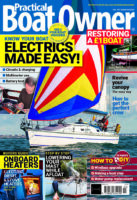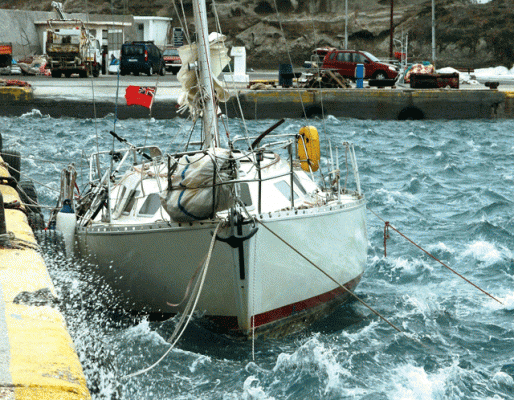Rupert Holmes describes the course of action he pursued – and the lessons learned – when storm conditions threatened to cause damage to his moored boat
Handling rough conditions in port: lessons learned
We were in Agios Efstratios, one of the most remote inhabited Aegean Islands, at the very end of October, sheltering from a deep depression moving slowly west across the Mediterranean. Even that far west they can still pack a powerful punch, but tend to be slow-moving by the time they reach the Aegean.
This one was forecast to blow Force 8-9 from the south and south-east before reducing a little, then veering towards the west and increasing to a similar strength.
We prepared my Discovery 3000 Ammos well for the initial winds: from that direction the island shelters the small harbour on Agios Efstratios, but there was still a 300- to 400m-long fetch to contend with.
Although Ammos is a 30ft (9.1m) boat of moderate displacement, we carry warps and fenders that would work for a boat 10ft (3m) longer. Even then, we rigged additional mooring lines so that if one broke there would still be another in its place to do the same job while a replacement back-up was rigged.
We also put a fender board (actually the boarding plank) outside the fenders and laid an anchor out to windward to reduce the pressure on the fenders. In addition, there was a conveniently-placed tractor tyre on the quay wall that provided extra protection.
Given that were was plenty of space – there were no other yachts there at that time of year – we opted to lie alongside, rather than anchoring stern to the quay in a more conventional Mediterranean fashion. The downside of anchoring stern-to is that you are totally reliant on the anchor, and on it not dragging at all as the wind increases. This may be fine in summer conditions, but not in a significantly stronger winter storm.

Lying safely clear of the quay. The waves beyond the end of the breakwater meant that leaving the harbour was no longer a viable option
Everything was fine in the early part of the storm, even though 2ft waves caused Ammos to pitch significantly up and down next to the quay. Spray regularly broke over the foredeck, but we never felt the boat was in any danger.
The cold front came through the following afternoon, passing very slowly and bringing several hours of heavy rain, accompanied by much thunder and lightning – we saw many strikes on the island’s 300m-high peak. After the rain cleared, shortly after sunset, there was a long period of calm. Much lightning was visible over Turkey for hours, with spectacular bolts and flashes at a very high frequency.
Violent storm rages through Portugal boatyard – 60-knot winds from the top of a boat cradle!
Missed opportunity
This calm period should have been our window to clear out of the harbour and get safely out to sea before the wind restarted from the south-west and west, where the harbour wall would be our only protection. However, lulled into a false sense of security by the calm and clear skies overhead, we didn’t follow our instincts. We did at least use this time to recover the anchor, as we were expecting to be blown off the quay once the wind came in from west of south.
At around 0200 the following morning we awoke to find the wind increasing from the south-west. We adjusted lines and checked them for chafe before turning in for some more sleep. Two hours later we were woken again, this time disturbed by one of the two stern springs breaking.
The tops of the biggest waves were now washing over the end of the breakwater, with swell rushing along the edge of the quay as tonnes of water cascaded into the harbour. This was accompanied by a torrent of water moving along the quay towards Ammos, causing her to try to surge rapidly backwards and forwards.
This was the most worrying development so far and the wind was forecast to continue increasing, so conditions in the harbour were only going to get worse.
At this stage the fender board was interfering with the fenders, so we took the board off and at same time rigged even more mooring lines: although Ammos is only 4.5 tonnes, our 14mm lines were feeling quite light by this stage. We were soon pressing all suitable lines into service – even the spinnaker sheets.
A couple of hours later Ammos was still trying to surge rapidly back and forth along the quay with each wave that washed over the end of the breakwater, and was pitching considerably. We hadn’t at this stage incurred any damage beyond a popped fender and more broken lines: these were quickly joined with a double sheet bend so they could be put back into service.

Note the anchor hanging from a couple of bow lines, significantly reducing the shock loadings, and the waves breaking on the beach to the right
Move away from the quay!
By this stage we were starting to attract attention from local fishermen, who unanimously suggested we should slacken the mooring lines with the object of allowing the boat to drift clear of the quay.
Certainly there was merit in this idea, but even though the wind was theoretically blowing us off, Ammos was almost totally sheltered in the lee of the tall harbour wall: simply slackening the lines would have just seen us surging back and forth along the dock even faster, and would have certainly resulted in damage.
At this stage, the situation looked grim – would enough fenders last until the wind abated, and would we be able to keep replacing lines as they broke? If not, how much damage might Ammos sustain? It felt as though the boat was in more danger than in any other situation in the 70,000 miles I have sailed: although, providing we took sensible precautions, we weren’t in danger ourselves.
A viable solution?
By this time it looked as though the small ferry that moored in the berth astern (ie inshore of us) might not be arriving that day, which opened up more options.
Given that plenty of Aegean harbours have less than perfect shelter, when I bought Ammos
I also bought a 100m-long floating polypropylene mooring line: until now, this had lain unused in the bottom of the cockpit locker.
This line was long enough to reach right round to the quay on the opposite side of the harbour, and I was then able to use it to pull my boat’s stern away from the quay, winching the line in on a primary winch while simultaneously easing the other mooring lines. It worked perfectly, with Ammos bobbing safely up and down, initially half a boat length clear of the quay. It was also apparent that she would be safe even in much rougher conditions, providing the mooring lines held. All the same, I was not yet completely happy with the situation – we were still snatching at the bow lines and were relying solely on the now bar-taut polypropylene rope to keep us off the quay.
The first problem was solved by taking the main anchor rode (25m of 8mm chain plus 75m of 18mm warp) around to the quay opposite. Once this was rigged we were much more secure, with the weight of the chain helping to significantly dampen fore and aft movement.
Snatching eliminated
Next I used the 16mm kedge warp doubled up as two additional bow lines, protecting them from chafe at the boat end with an offcut of heavy-duty sanitary hose. We then hung the bower anchor from these lines, which all but eliminated any snatching.
Phew! Ammos was now 100% safe even if the wind picked up another couple of notches, especially given that we had backed up as many lines as possible on winches, so we weren’t relying solely on the foredeck cleats.
We had been working solidly for 10 hours, following a disturbed night, and it was now time to have some lunch and get some rest. At 1500 the wind veered to the west and rapidly decreased to only 10-15 knots, and the sea state eased simultaneously. This allowed us to undo the day’s work, bringing Ammos back alongside and allowing the small ferry unhindered access to its berth when it eventually arrived at 1830.
The rest of the voyage was uneventful, although on the 80-mile sail west from Efstratios to Panormos on the island of Skopelos we passed a front that spawned an improbable number of waterspouts: at one time we could see half a dozen.
Given the previous day’s events, it felt odd to be heading towards them under spinnaker, but we had perfect sailing conditions with an east-south-easterly breeze of 12-16 knots. As a precaution we made sure we were prepared to drop the sails rapidly and made sure there was nothing unsecured on deck. In the event we passed under the front with no problem, but there was no wind in its wake, leaving us motoring the final 30 miles to Panormos.
Light losses
We lost one fender – our biggest and best, of course. Fortunately most of the broken lines could be spliced back together, losing only a small amount of length. There was also some chafe to the spinnaker sheets, but not enough to prevent them continuing to be used for that purpose. Other than that, there was just a black mark on the hull from occasional light contact with the tractor tyre: this was easily polished out.
LESSONS LEARNED
1 Don’t give up – even in the face of seemingly overwhelming odds there’s usually something that can be done to manage and improve a situation without exposing crew to potential harm, and boats can come through a lot without significant damage. In the end, after a short night of disturbed sleep we worked for almost 15 hours with only one short break, but the reward was minimal damage.
2 It really helped to have plenty of good-size fenders, and a boat full of rope that we could keep drawing upon for different purposes. Both are a must for any serious cruising boat.
3 It doesn’t pay to be complacent. The need for good seamanship – and vigilance – doesn’t stop when you tie the boat up.
4 Trust your instincts, even when it’s not convenient to do so. Ammos is a well-equipped boat and set up to take heavy weather in her stride, so we should have taken the opportunity to leave the night before, during the calm after the front. Had we done so we would have had time to reach
open water before the wind built to Force 8/9, and then hove to comfortably or laid ahull overnight and until the wind eased the following afternoon.
Enjoyed reading Handling rough conditions in port?
A subscription to Practical Boat Owner magazine costs around 40% less than the cover price.
Print and digital editions are available through Magazines Direct – where you can also find the latest deals.
PBO is packed with information to help you get the most from boat ownership – whether sail or power.
-
-
-
- Take your DIY skills to the next level with trusted advice on boat maintenance and repairs
- Impartial in-depth gear reviews
- Practical cruising tips for making the most of your time afloat
-
-






